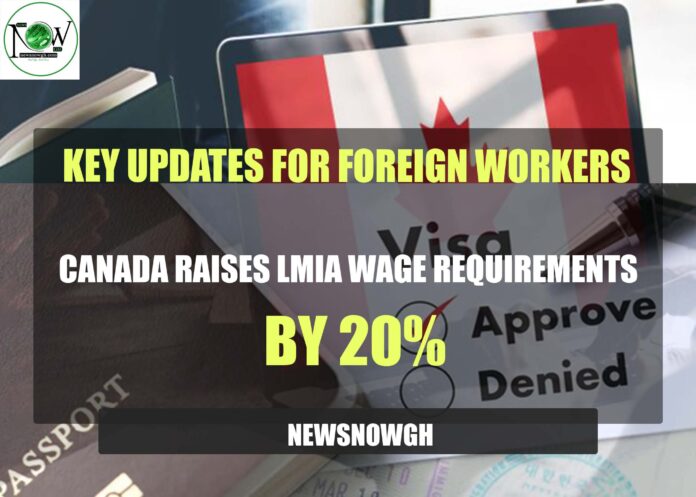Canada Raises LMIA Wage Requirements by 20%: Key Updates for Foreign Workers!
With effect from November 8, 2024, Canada has revised the pay levels for the Labour Market Impact Assessment (LMIA) program. These modifications impact hiring practices in every province and territory by raising the minimum salary requirements for foreign workers by 20%.
Employers who hire foreign talent will be impacted by Canada’s increased salary standards for the Labour Market Impact Assessment (LMIA) program. Employers in all provinces and territories must comply with the new salary rules for foreign workers under the Temporary Foreign Worker Program (TFWP) as of November 8, 2024.
These changes are a reflection of Canada’s emphasis on equitable employment practices, controlling inflation, and adjusting to the nation’s changing economic landscape. A summary of the recent modifications and their implications for Canadian companies and temporary foreign workers (TFWs) may be found here.
What Caused the Change?
Canada’s dedication to fair work standards, keeping up with inflation, and adapting to the changing job market is reflected in this update. All provinces and territories will see a 20% boost in wages under the new standards.
Comprehending the New LIMA Standards
When appropriate local candidates are unavailable, Canadian firms may hire foreign workers through the Temporary Foreign Worker Program (TFWP). Employers are required to accomplish this by completing a Labor Market Impact Assessment (LMIA), which evaluates the effects of hiring a foreign worker on the Canadian labor market. The LMIA process is divided into two main streams:
- High-salary Stream: For jobs that pay at or above the provincial or territorial salary level.
- Jobs paying less than the provincial or territorial wage threshold are classified as low-wage streams.
All Canadian regions have seen a 20% increase in the wage criteria for both streams as of November 8. To comply with LMIA regulations, employers must make sure that the wages they offer reflect these current rates.
Updated LMIA Wage Thresholds by Province and Territory
The pay thresholds before and following the November 8 update are shown below:
- Alberta: From $29.50 to $35.40 will be the new pay level.
- British Columbia: The new minimum wage is $34.62 instead of $28.85.
- The wage rate in Manitoba has changed from $25.00 to $30.00.
- The wage threshold in New Brunswick has been raised from $24.04 to $28.85.
- Newfoundland & Labrador: $41.20 instead of $26.00.
- Wage rates in the Northwest Territories increase from $39.24 to $47.09.
- The threshold in Nova Scotia is now $28.80 instead of $24.00.
- Nunavut: Raise to $42.00 from $35.00.
- Ontario: The minimum wage is now $34.07 instead of $28.39.
- The threshold for Prince Edward Island increases from $24.00 to $28.80.
- Quebec: Raise to $32.96 from $27.47.
- Wage rates in Saskatchewan will increase from $27.00 to $32.40.
- Yukon: The minimum wage is now $43.20 instead of $36.00.
Highlights of the Province: Significant Wage Changes
- Alberta: Employers in high-demand industries including construction, technology, and energy are being impacted by the wage threshold’s increase from $29.50 to $35.40.
- British Columbia: Due to the growing cost of living and the need for qualified personnel in the service, healthcare, and technology sectors, employers are now required to pay a minimum wage of $34.62 for high-paying positions.
- In Ontario, the minimum wage has increased from $28.39 to $34.07. Businesses in Toronto, Ottawa, and Hamilton will be especially impacted by this increase, particularly those in high-demand industries like finance, healthcare, and information technology.
- Quebec: Industries like manufacturing, hospitality, and services will need to modify their wage offers to recruit French-speaking personnel since the wage barrier has increased from $27.47 to $32.96.
- Saskatchewan and Manitoba: The current wage requirements, which are $32.40 for Saskatchewan and $30.00 for Manitoba, will be raised for the agricultural and resource-based economies in these provinces. Pay scales may need to be updated by employers, especially in the mining, logistics, and agricultural industries.
The Effects of These Changes on Foreign Workers and Employers
By taking into account local economic conditions, the revised pay criteria seek to provide appropriate compensation for international workers. Employers and TFWs should be aware of the following:
Effect on Employers
- Budgeting Changes: Companies must modify their budgets to hire foreign talent in light of the 20% increase in wage criteria. Hiring plans may be impacted by this shift, particularly in industries where salaries are crucial.
- Simplified Applications for LMIA: Certain requirements, like training plans for Canadian workers, are frequently unique to high-wage LMIA applications. By revising wages to the new rates, employers who were previously just paying wages slightly below the old barrier may now be eligible for the high-wage stream.
- Industry-Specific Challenges: The revised wage criteria may result in greater operating expenses for industries like construction, hospitality, and agriculture, where foreign workers are frequently necessary. Companies may need to reconsider their salary and hiring policies.
Implications for Temporary Foreign Employees
- Opportunities for Higher Wages: The revised thresholds are intended to give TFWs competitive compensation in line with regional cost-of-living patterns. This could improve international workers’ financial security in Canada.
- Pathways to Permanent Residence: Higher-paying jobs may make it simpler for foreign workers to be eligible for economic immigration programs that give preference to well-paying occupations, increasing their chances of obtaining permanent residence.
Gazing Ahead
TFWs will receive fair remuneration thanks to these new salary norms, which also help maintain a balanced labor market. While international workers are paid competitively, employers still have access to the talent they need. To maintain compliance with Canada’s changing employment rules, both employers and TFWs must stay up to date on these developments.
Follow us on Newsnowgh.com to stay updated on the latest information regarding work permits, visa application processes, paths to permanent residency, and visa-sponsored employment.


